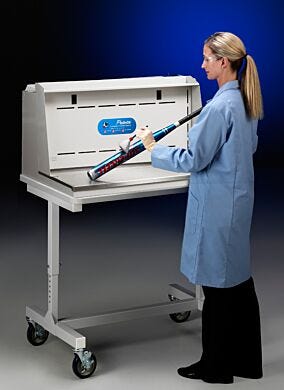- (714) 578-6016
Hours Mon - Fri, 07:00 AM - 06:00 PM (Pacific Time)
Worldwide Pricing and Secure Global Shipping Available!
- Get a QuickQuote
- Free Consultation (714) 578-6016
- Track Order Sorry, no orders are open for tracking
- Home
- Protector Downdraft Powder Stations by Labconco

Product Group:
1538-PP-04
1538-PP-04 71358
Protector Downdraft Powder Stations by Labconco
Read more
Manufactured By: Labconco
Print
Want a quote quickly ?
Submit a QuickQuote requestProduct Details
Product Details
Product Details
- The Protector Downdraft Powder Station effectively contains fine powders, making it ideal for fingerprint dusting and similar forensic procedures
- Built-in blower with motorized, backward-curved fan pulls airborne dusts and powders away from the operator, drawing the particulates through a HEPA filter before exhausting the air back into the room
- Both the work surface and the rear wall feature airflow perforations strategically positioned to capture airborne particulates generated within the workspace
- Perforated, stainless steel work surface lifts for easy access to powder collection pan
- Work surface and powder collection pan detach for cleaning or transport to remote locations
- Top shelf conveniently holds fingerprint powder, brushes, small instruments and supplies
- Exhaust HEPA filter is 99.99% efficient on particles 0.3 micron or larger
- Open-face design offers greater versatility than a typical hood, particularly when processing large, oddly shaped items
- Multiple units can be placed side-by-side to accommodate longer pieces of evidence (requires Labconco’s Transition Connector Kit)
- Filter alarm light alerts operator of low airflow conditions, usually a sign of filter saturation
- MERV 8 pre-filter captures fine dusts, prolonging the life of the blower and HEPA filter
 Protector Downdraft Powder Station
Protector Downdraft Powder Station Protector Downdraft Powder Station
Protector Downdraft Powder Station
- of 2Start Over
Protector downdraft powder stations by Labconco shown with optional stand Protector Downdraft Powder Station Labconco's Protector Downdraft Powder Station is ideal for forensic applications such as fingerprint dusting. These powder stations are open-sided, open-top design provides unrestricted operator movement.
Protector downdraft powder stations by Labconco shown with optional stand | 1538-47 displayed Protector Downdraft Powder Station Labconco's Protector Downdraft Powder Station features an open design that allows long or awkwardly shaped items to be processed as easily as small objects.
Protector downdraft powder stations by Labconco shown with optional stand Protector Downdraft Powder Station Labconco's Protector Downdraft Powder Station is ideal for forensic applications such as fingerprint dusting. These powder stations are open-sided, open-top design provides unrestricted operator movement.
Protector downdraft powder stations by Labconco shown with optional stand | 1538-47 displayed Protector Downdraft Powder Station Labconco's Protector Downdraft Powder Station features an open design that allows long or awkwardly shaped items to be processed as easily as small objects.
Features & Benefits
Features & Benefits
Dedication to Business Ethics
Terra is committed to conducting business according to the highest standard of professional ethics and conduct. To review Terra’s ethics code, please visit: https://www.terrauniversal.com/ethics-policy/
Protecting Personal Information
Terra is committed to ensuring that our customer’s personal information is secure. In order to prevent unauthorized access or disclosure, Terra has developed procedures to safeguard and secure information collected online and offline.
Available Accessories
Popular Accessories
For a full list of accessories, select a product then click Choose Accessories on that product page.
Variable Height Mobile Bench
Labconco offers an adjustable, mobile workbench that can be used as a base stand for Protector Downdraft Powder Stations. The bench is constructed of powder-coated steel with a high-pressure melamine laminate top for durability and cleanliness.Prefilter: Replacement for Protector Downdraft Powder Stations,17.8W x 14.8D x 0.8H
Products similar to this one
Other products you may find relevant
- Group of 8 productsSure-Grip® EX Undercounter Flammable Safety Cabinets by Justrite FromAs low as $1,136Some ship in 8 - 12 days
- Group of 10 productsSure-Grip® Flammable Liquid EX Safety Can Storage Cabinets from Justrite FromAs low as $1,120Some ship in 3 - 5 days
- Group of 21 productsErgoHeight® Electric Height Adjustable Cleanroom Workstations FromAs low as $1,659Some ship in 1 - 3 days
- Group of 4 productsProtective Industrial Products, Inc. Qualatrile® XC Nitrile Gloves FromAs low as $220Some ship in 15 - 15 days
Page 1 of 7
Buy Accessories
Manuals & Resources
Manuals & Resources
PASSWORD REQUIRED
for




























